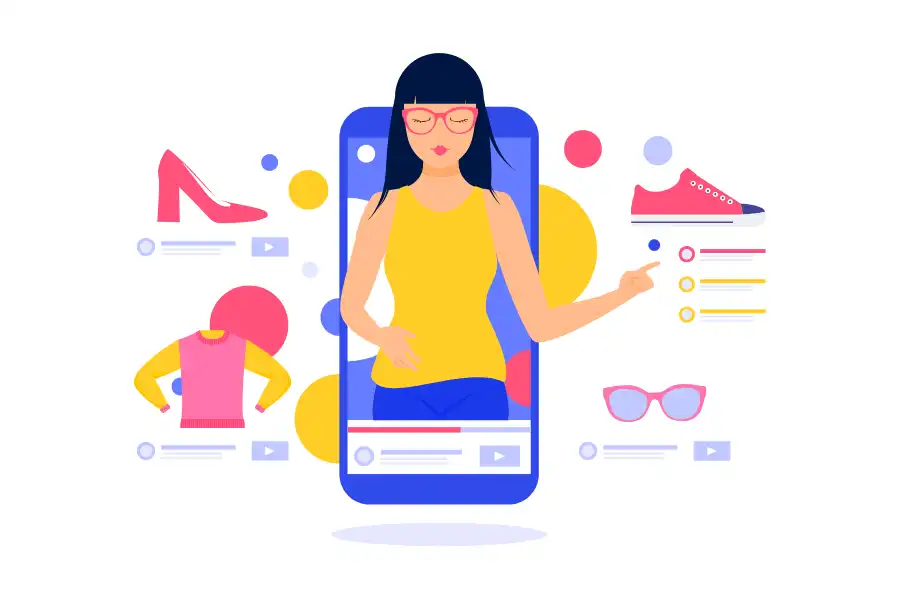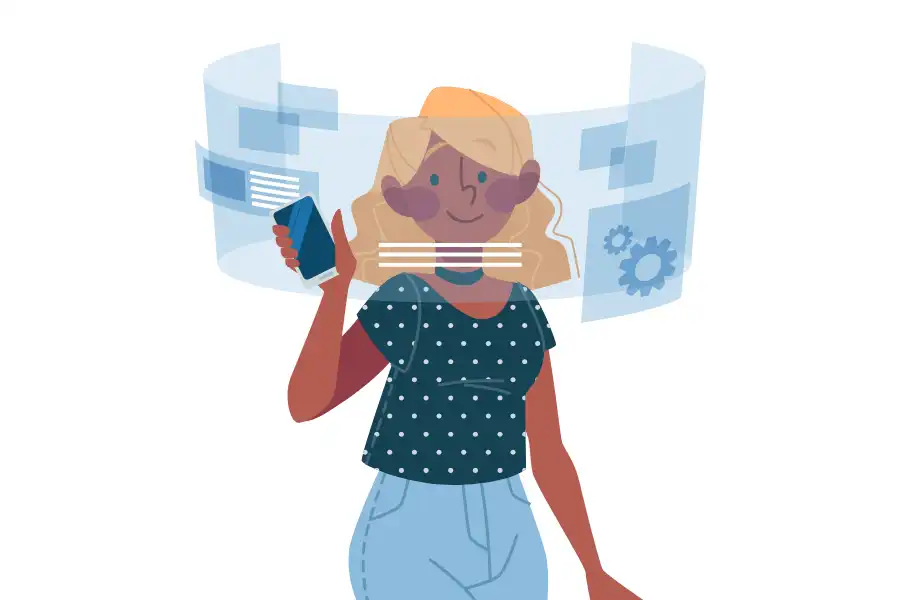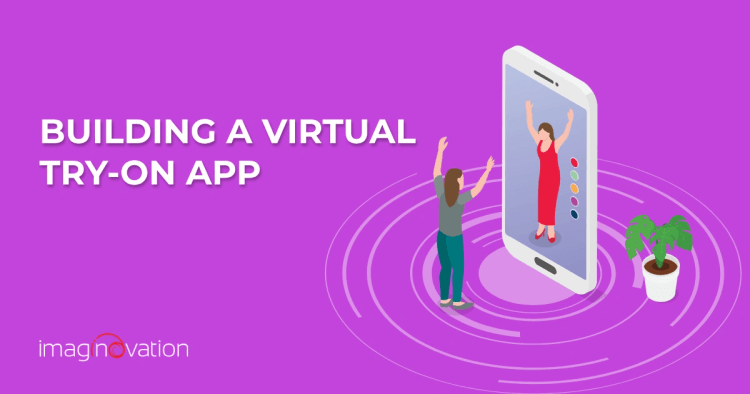Imagine ordering a new jacket that looks stunning online, only to be disappointed later when it doesn't fit properly and is far from your expectations.
Isn’t that a common frustration with online shopping? Whether it's clothes, jewelry, makeup, sunglasses, shoes, or even furniture, being unable to physically try products before buying often results in returns and exchanges.
But what if there was a way to virtually “check” and "experience" online products before purchasing?
A virtual try-on app makes this possible.
This guide to building a virtual try-on app will explore its benefits, use cases, real-world examples, and step-by-step development process.
Read on to discover how virtual try-on apps revolutionize online shopping by offering a unique edge over the traditional shopping experience!
What is a Virtual Try-On App?

In simple terms, a virtual try-on app functions like a digital dressing room, allowing you to try on items such as sneakers, watches, and clothes and even test makeup before making a purchase.
These apps enhance the online shopping experience by letting you see how items look and fit, helping boost sales without requiring a visit to a physical store.
The virtual try-on apps work by overlaying a digital version of the product onto your real-world image captured through your mobile device's camera. It lets you visualize how products look and fit in your physical space, creating a more immersive and engaging shopping experience.
Virtual try-on apps rely on augmented reality (AR) software, artificial intelligence (AI), machine learning (ML) algorithms, and 3D modeling to accurately map your movements and the products you're trying on.
They also depend on your smartphone's cameras, sensors, and processing power to render realistic virtual representations. Additionally, integration with online shopping platforms lets you easily add products to your cart and complete a purchase from the app.
And it's not just makeup and clothes! You can use these apps for selecting home decor, appliances, furniture, and more. Many major brands use this tech to bring product trials to customers’ homes.
For businesses, these apps provide valuable insights into customer preferences, enabling them to refine product offerings and marketing strategies. A survey confirmed that businesses reported a 2.5 times boost in sales conversion upon implementing virtual try-on technology. (Source)
The global market for virtual try-on technology was valued at $9.17 billion in 2023 and is projected to reach $46.42 billion by 2030, growing at a 26.4% compound annual rate. (Source)
In 2022, 12% of online shoppers in the U.S. had already used virtual try-on apps. (Source)
These apps help online retailers combat one of their biggest challenges—returns. Around 30% of online purchases are returned, with handling costs ranging from 20% to 70% of the original sale price, significantly impacting profit margins. (Source)
With its many benefits, virtual try-on technology offers a promising solution for customers and retailers.
Benefits of Virtual Try-On Apps
More and more brands rely on virtual try-on tech to offer a shopping experience like never before. Let’s see what are the benefits of virtual try-on apps for businesses as well as customers:
1. Reduced return rates of products.
Most businesses agree that most returns aren't due to defective products but rather a mismatch between customer expectations and the product. That's why companies are finding virtual try-on apps helpful. They allow online shoppers to see how items will look on them, making it easier to choose the perfect style, fit, and color—leading to better purchasing decisions and fewer returns.
2. Enhanced customer satisfaction.
Virtual try-on apps based on AR offer users a unique and innovative shopping experience, encouraging them to return for more shopping. Moreover, when shoppers visualize how a range of items will look on them, they feel more confident about their choices, making the whole shopping experience engaging and fulfilling.
3. Increased sales and conversion.
The interactive features of your virtual try-on app can dramatically boost customer conversion rates. As customers feel confident about their shopping choices through the app, they are more likely to complete sales transactions, which boosts conversions and business growth.
4. Enhanced brand loyalty.
Online shoppers are likelier to stick to brands offering a real-time shopping experience. A virtual try-on app provides an engaging experience that lets customers overcome the hesitation and uncertainty associated with e-shopping. This positively impacts customer brand loyalty.
5. Hyper-personalization.
Virtual try-ons go beyond mere visualization. They offer the personalized experience that in-store shopping often does, giving customers clarity on whether the chosen sweatshirt fits them as they want to, if the lipstick suits their skin tone, or if the earrings look too small. These apps allow for the customization of product options to individual user preferences and allow for real-time adjustments accordingly.
6. Valuable data insights for retailers.
Virtual try-on apps help retailers by providing valuable data insights. These apps use technology like AI body modeling and digital avatars to track how customers interact with products. Retailers can learn about customer preferences and trends, helping them improve their offerings and create a better shopping experience.
Use Cases of Virtual Try-On Technology
With the help of a virtual try-on app, online users can quickly try on products without leaving the comfort of their homes.
These apps solve a critical problem of most e-commerce apps: How can a consumer find out what a product will look like on them, and not just on the model's picture on their screens?
Some of the critical use cases showing their versatility are -

1. Apparel and fashion.
Virtual try-on technology allows online shoppers in the apparel industry to see if clothing fits their expectations without needing to try it on physically. With advanced AR features, users can mix and match outfits, adjust sizes, and change colors to find their perfect fit.
2. Beauty and makeup.
Virtual try-ons in the beauty industry let customers experiment with makeup products like lipstick, eyeliner, hair color, and eyeshadow based on their skin tone and facial features. Customers can try glossy or matte colors, shades, and finishes. Some companies also offer AR-based tutorials to help customers apply products correctly.
3. Eyewear.
For eyewear, virtual try-on apps allow users to experiment with different frame styles, shapes, and lens colors of glasses. Users can make informed decisions by virtually trying on frames and finding the perfect fit for their glasses or sunglasses.
4. Furniture and home decor.
Virtual try-on apps allow users to visualize furniture and home décor items, checking their dimensions, patterns, colors, and designs. The app's AR capabilities allow users to digitally place these items (curtains, bookshelves, sofas, plants, artwork, etc.) in their living spaces to see if they match the interior and fit the space.
5. Cosmetic surgery.
Many patients feel anxious about cosmetic procedures like liposuction or rhinoplasty. Virtual try-on apps provide digital previews that ease their concerns and help them set clear expectations before surgery. These apps help patients make informed decisions by showing potential results.
6. Tattoo.
With Tattoo try-on apps, users can browse various designs and even upload their own. They can then try them on by placing them on their body parts. Only when they are convinced can they choose a specific design.
7. Tourism.
Virtual try-on apps for travel let users have immersive experiences when planning trips. Users can take virtual tours of hotels, resorts, attractions, and landmarks. This helps them check out accommodations and travel experiences before booking their trip, making travel planning easier.
Building Your Virtual Try-On App
Virtual try-on solutions are gaining popularity. Every step, from the research and planning stages to app launch and beyond, is essential for the success of a virtual try-on app development process.
Let’s break down each step in detail.
1. Research and Plan.
Planning is crucial before you start building your virtual try-on solution. This first step, known as the research and planning phase, involves developing a clear strategy.
Here's how you can begin:
- Start by outlining your business objectives for the virtual try-on app. Do you aim to enhance customers' shopping experience, reduce product return rates, or drive sales?
- Clearly define your app goals with the help of the development team. App features will be tailored accordingly in later steps.
- Think about who will use your app and why. Are you targeting tech-savvy Gen Z users who love AR and VR experiences? Or are you reaching out to an older audience who may not be as comfortable with technology?
- Take time to study how competitors in your industry are using digital try-on technology. Understand their strategies, strengths, and weaknesses.
This knowledge will help you build a virtual try-on solution that excels in areas where others may fall short.
2. Enlist relevant features and critical technologies.
Now that you understand your customers' needs, decide your app's key features and technologies. Remember that not all tech trends are necessary—choose features that align with your business goals. Here are some of the features you may include -
- A 3D gallery of products for rotating and zooming in and out of products.
- An intelligent search and suggestions engine for the user to help cut down their search time on your app.
- A 3D product configurator that allows you to showcase your product as a 3D model, customizable in real-time.
- A flawlessly designed payment system to complete the payment transaction.
- A user account with options to access discounts and connect with social media connections.
Make sure to select the key technologies, such as -
- Computer Vision: Enables devices to interpret visual information. In virtual try-ons, it analyzes body shape and sizes, accurately mapping clothing items onto your image.
- Augmented Reality: AR overlays digital information onto the real world. In virtual try-ons, AR shows how clothes look on you in real-time through your camera.
- Machine Learning: Helps AI systems learn and improve. Machine learning algorithms refine virtual try-ons by analyzing user interactions and feedback, enhancing accuracy and intelligence over time.
3. Design User Interface (UI) & User Experience (UX).
Build a virtual try-on solution that is user-friendly, intuitive, and feature-rich while also maintaining good performance. Here are the critical UI/UX features your app should have -
- An easy-to-use design that is clean and clutter-free, allowing users to navigate and try on products quickly without distractions like ads.
- An immersive user experience with clear instructions, fast loading times, and interactive elements that make the virtual try-on app fun and informative.
4. Develop app prototype and MVP.
This stage involves -
- Creating a basic version of the app with core features to test usability and gather feedback.
- Developing a stripped-down version of the app called MVP (minimum viable product). An MVP offers all the essential features to launch and test in the market, allowing for iterative improvements based on user feedback.
This stage helps refine the app's functionality, design, and user experience before a full-scale app launch.
5. Integrating essential systems and API.
Essential systems like databases, servers, and user authentication are connected to ensure the smooth operation of the app. In addition, make sure -
- APIs are incorporated to enable communication with external services or platforms for features like product data retrieval or payment processing.
- Augmented Reality technology is integrated to overlay virtual clothing items onto the user's image in real time for a more interactive try-on experience.
- Machine Learning algorithms are used to analyze user interactions and feedback, enhancing the accuracy and intelligence of the virtual try-on system over time. Use a diverse set of data and images to train your app.
6. Test and refine.
At this stage of virtual try-on app development, testing your app thoroughly is essential.
Testing and refining are crucial for a successful virtual try-on system.
Before you launch your virtual try-on solution:
- Conduct Beta Testing. Invite diverse users to test the app, identify issues, and learn how users interact with the app.
- Gather accuracy, usability, and overall experience feedback to make necessary improvements.
- Check for performance optimization. Ensure the system works well across different devices and at different internet speeds.
7. Launch & maintain.
Here's what you should do at this stage of virtual try-on app development -
- Based on whether this app is meant for Android or Apple users, launch your app in the relevant app store.
- Organize a prelaunch phase to generate excitement and anticipation for the app. Use social media for that.
- Host a well-organized launch event to introduce the virtual try-on app to users.
- Gather feedback post-launch to make necessary adjustments and enhance the user experience.
- Keep updating your app regularly with new features and enhancements.
- Monitor the app's performance, scalability, and security to ensure smooth operation.
Real-World Examples of Successful Virtual Try-On Apps
Here are some real-world examples of virtual try-on apps businesses have launched successfully.
1. Warby Parker.
Warby Parker is an online retailer of glasses and sunglasses. Its virtual try-on app allows iPhone and Android users a personalized shopping experience from the comfort of their phones.
Using the device’s front-facing camera, the app's 'try-on virtually' feature lets users instantly try on Warby Parker frames. This allows them to see how different styles—like cat-eye, rectangle, or round frames—and different colors- will look on their faces.
Warby Parker then lets customers pick five frames online and sends them to the customer to try for free before buying. Trying the glasses at home helps customers decide on the best fit since glasses are unique, and slight differences can impact comfort and style.
2. e.l.f. Cosmetics.
The e.l.f. Cosmetics app lets customers try over 300 products using its virtual try-on feature. Users simply upload their pictures to see how concealers, foundations, and lip products would look on them.
e.l.f. cosmetics has succeeded with AR campaigns on YouTube, which have led to more site visits and lower bounce rates.
In the app, users can tap "Try It On" and use their camera to see how products look on them. They can switch shades and colors and easily buy the product from the e.l.f. Cosmetics website for a more personalized shopping experience.
3. Baume and Mercier.
Baume & Mercier, a luxury watch company, offers customers a virtual try-on experience. They understood that customers don't take buying expensive items lightly and appreciate the option to try before purchasing.
The virtual try-on includes watches in various sizes and styles, with attention to detail like lighting and shadow effects for a realistic experience. User testing helped ensure the process felt natural and intuitive for customers.
Baume and Mercier have hosted the virtual try-on directly on their website to make it convenient for users, with no app download required.
Future Trends in Virtual Try-On Technology
Virtual try-on technology transforms shoppers' online shopping journeys from start to finish. Advancements in AR, VR, AI, and ML are driving this trend, offering personalized recommendations and engaging experiences for shoppers.
AR makes virtual try-ons more realistic, allowing customers to see products in a real-world setting and make better decisions without needing in-person try-ons. AI and ML enhance this experience by providing tailored recommendations based on user's style, preferences, and past purchases. This personalization boosts customer satisfaction.
Moreover, the gap between real-world shopping and e-shopping is reducing with the help of these apps.
Companies like Glam Labs offer lifelike virtual try-ons, and according to Forbes, these solutions can significantly increase conversion rates and revenues. The global market for virtual try-ons is expected to grow to over 25 billion USD by 2032.
As technology advances, it's expanding into new areas like clothing, jewelry, beauty, home décor, entertainment, and even cosmetic surgery. Millennials and Gen Z, who are comfortable with digital tools, are driving this shift.
The future of virtual try-on technology looks bright. It offers e-commerce companies a way to boost revenue, cut inventory costs, improve customer experience, and gain a marketing edge. The digital revolution in shopping is here to stay and will keep evolving.
Develop Virtual Try-On Solutions With Imaginovation
Virtual try-on technology is a game-changer for companies across various sectors.
If you choose the right virtual try-on app development partner, you can gain enhanced customer experience, increased engagement, reduced product returns, and boosted conversion rates.
Contact us at Imaginovation to learn how to create a seamless and immersive retail experience that appeals to today’s users and builds brand loyalty.
We will help you create a virtual try-on solution that reshapes your customers' online shopping experience.
Ready to build an app, but not sure where to start?
We've got you covered. Click the button below to get started.





